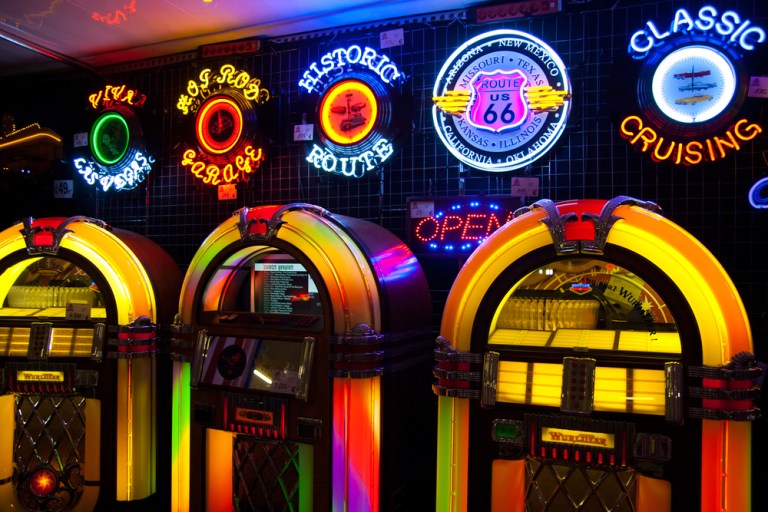
From a coin-operated box to mobile in-app payments – the way we pay-and-play at jukeboxes has changed drastically over the last century. Ron Richards, CTO of AMI Entertainment, took PYMNTS on a journey of the evolution of payments in the jukebox industry and what’s on the horizon for this entertainment staple.
The concept of paying for entertainment in a restaurant or bar 100 years ago may seem too far back to be relevant, but the evolution of payments in the space – from coins to cards to digital currencies – has an interesting story to tell.
And AMI Entertainment, which has been involved in the bar and restaurant entertainment industry since it was founded in 1909, has had a front row seat to all the technology iterations that have happened over the years.
“Going back 100 years ago the technology was really a player piano with a coin box attached and in some ways the sort of payment options and collection options haven’t changed that much believe it or not,” AMI Entertainment Chief Technology Officer Ron Richards explained.
Traditionally in the amusement industry, Richards said, amusement operators would purchase and own equipment – such as jukeboxes, pool tables, dart boards, ATMs, etc. – and then strike bargains with restaurant and bar owners to split the profits if they allowed the equipment to have a place in the venue.
Before the digital age rolled around, this was all cash-based and the operators would come straight to the venue to collect and split their earnings right there.
But this customarily cash-based business has been totally revamped with the onset of digital technologies, including those related to payments.
For the most part – outside of the old-school machines you can find playing vinyl records and only accepting coins – the jukebox industry has made the transition to digital.
Not only is there an entire digital network or hub that houses and distributes the music available on many of today’s modern machines, but new payments technologies are also impacting the way patrons pay and play on jukeboxes.
One of the biggest shifts that’s come into the industry in recent years, Richards noted, is mobile.
Today’s patrons don’t even need to walk up to a jukebox to make their selection, pay for it and hear their favorite tune.
AMI’s BarLink mobile app uses a gift card concept that enables users to load up money on their BarLink “wallet” and use that money to pay for the selection they want to hear at a restaurant or bar where an eligible jukebox is present.
Through a partnership with Stripe, BarLink utilizes tokenized credit card payments and gives patrons the ability to use as much of their money as they want, when they want for their musical selections.
Though the influence of mobile in the jukebox space is huge, it isn’t just impacting payments.
“Even in the digital age a patron was basically anonymous, it would be somebody that would come up, put a dollar bill or $5 into the jukebox, make their selections and go away,” Richards said. “Now, with the huge shift of our play selections to mobile, we are collecting more specific consumer-oriented data as well.”
“It gets us more than just payments – it gives our patrons the ability to make selections at the bar stool and it gives us more consumer profile data.”
Payments at the jukebox itself have had to advance in recent years as well.
Richards pointed out that a significant hurdle to accepting digital payments as opposed to just cash was the PCI compliance, because the jukebox itself was really the biggest point of vulnerability.
“It was physically secure because it’s still predominately a cash-based business even today, but with the PCI regulations there’s a lot of software security features that just don’t really fit well with the standalone jukebox or unattended payment kiosk model,” he added.
To overcome this challenge, AMI partnered with USA Technologies to encrypt payment data at the card reader itself. USA Tech also handles the security and tokens for decrypting the credit card data.
This has allowed AMI to “sidestep” any potential security issues, because encryption happens right where the payment is accepted on the machine and is then transmitted to USA Tech.
Richards said that AMI having the foresight to solve this problem five or six years ago has helped it to avoid a major issue that’s now being realized by other players in the market: turning off all jukebox-based credit card readers because they aren’t compliant.
While many face and try to overcome this compliance issue, they have been forced to shut down their credit card processing on the jukeboxes themselves, he noted.
For now, Richards said AMI’s main focus when it comes to payments is on its mobile capabilities and in-app payments.
Though the company has looked at both NFC and EMV payment adoption, it’s still determining when it makes the most sense to bring options like that to market.
For EMV specifically, Richards said the vending industry as a whole has been pretty slow to bite.
“Part of our challenge is because we are such a low-dollar vend, we have to make sure that whatever we adopt is efficient,” he said, adding that with such low vend amounts there is also a lower liability exposure.
“I can’t predict when we’d adopt it, I think it’s really a question of where things go in the consumer space in terms of demand for that kind of technology versus the cost aspect.”